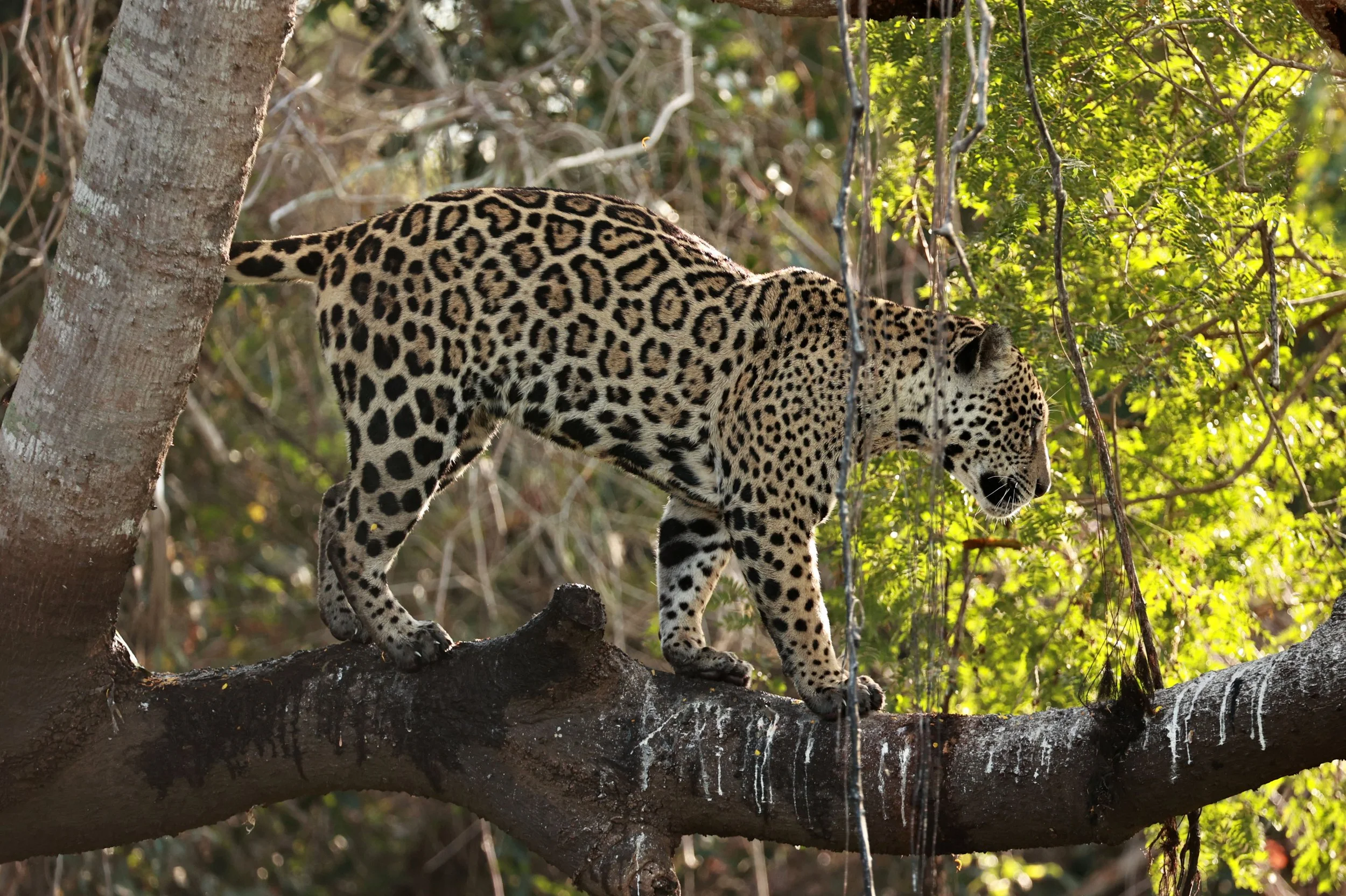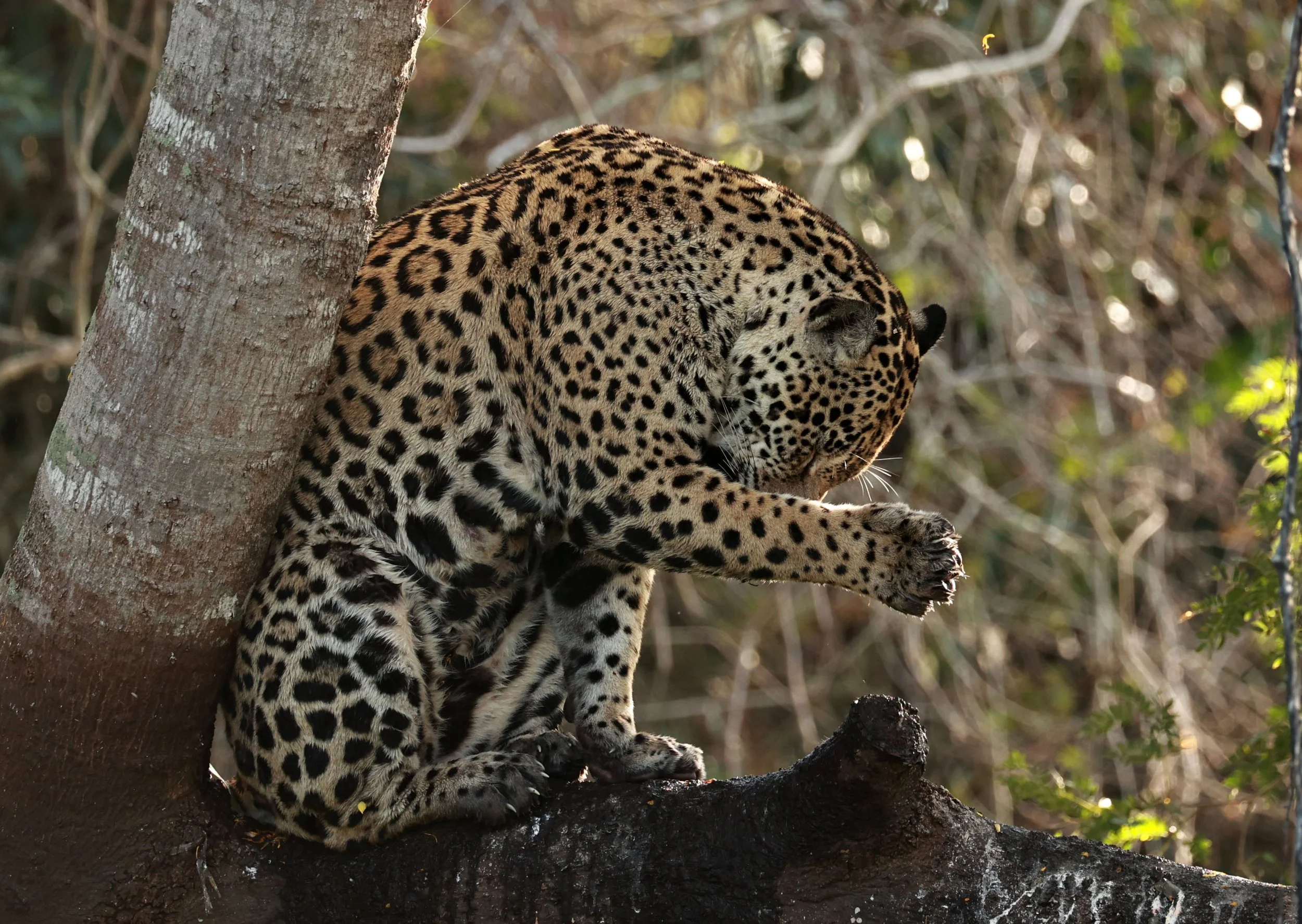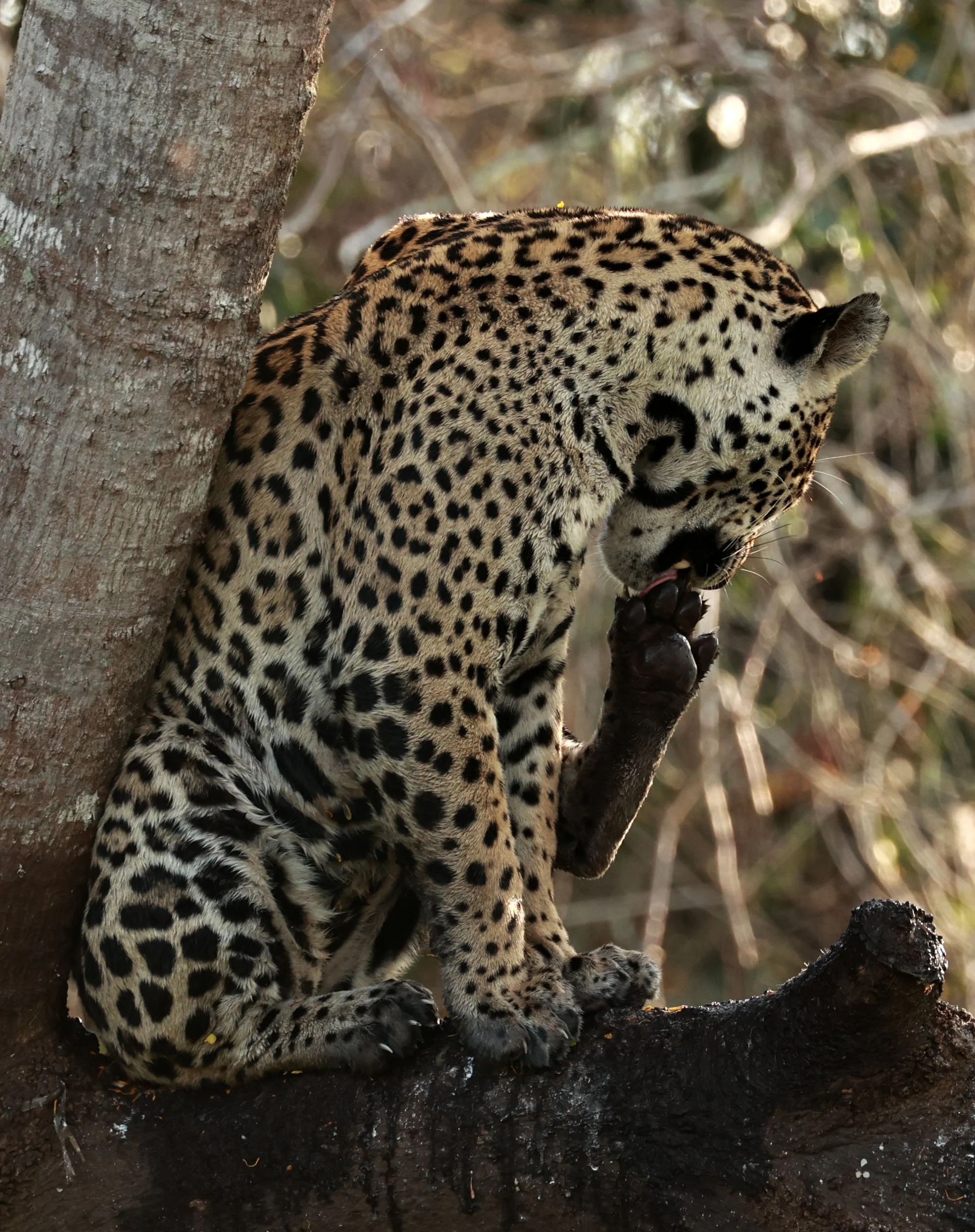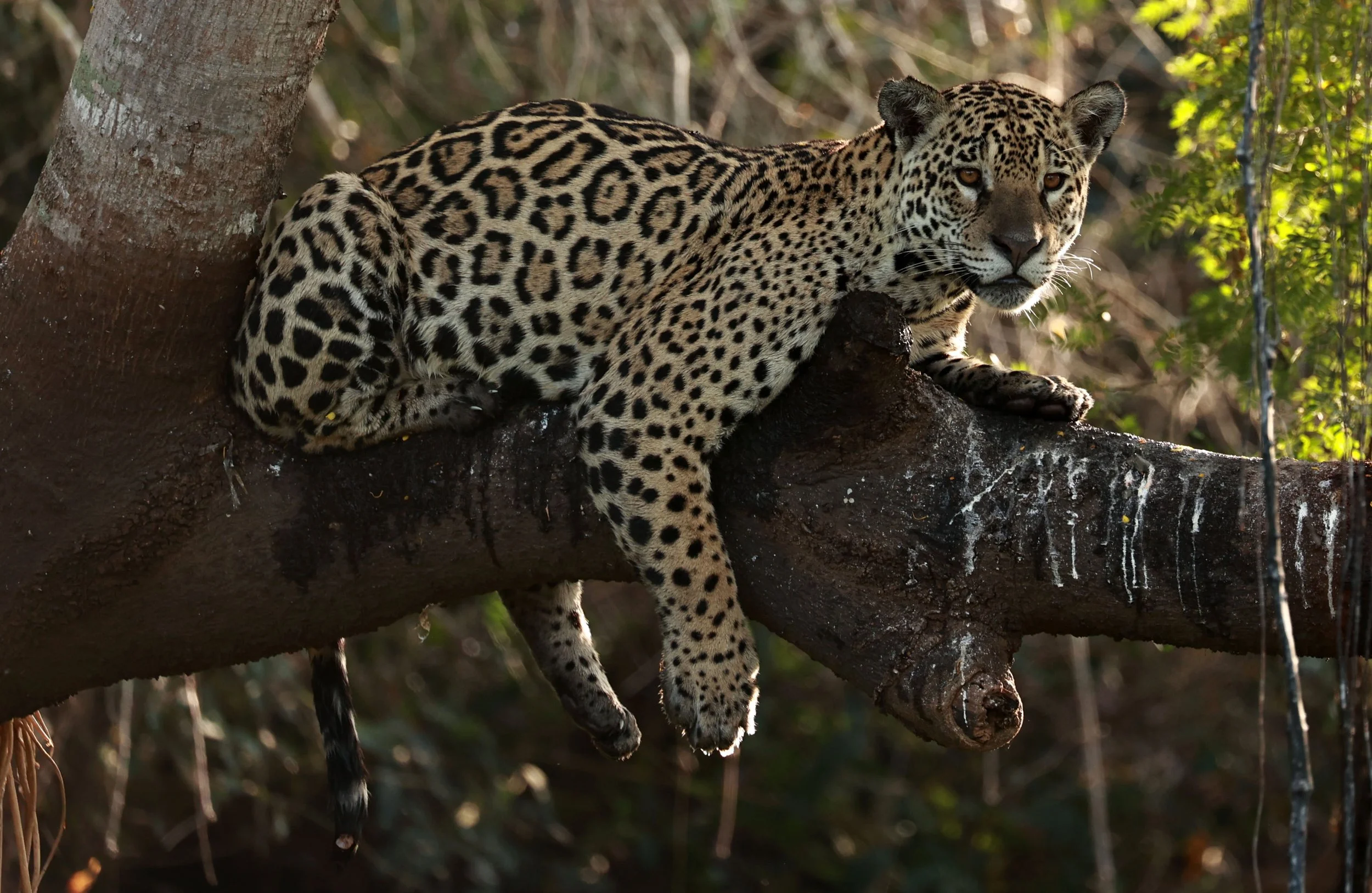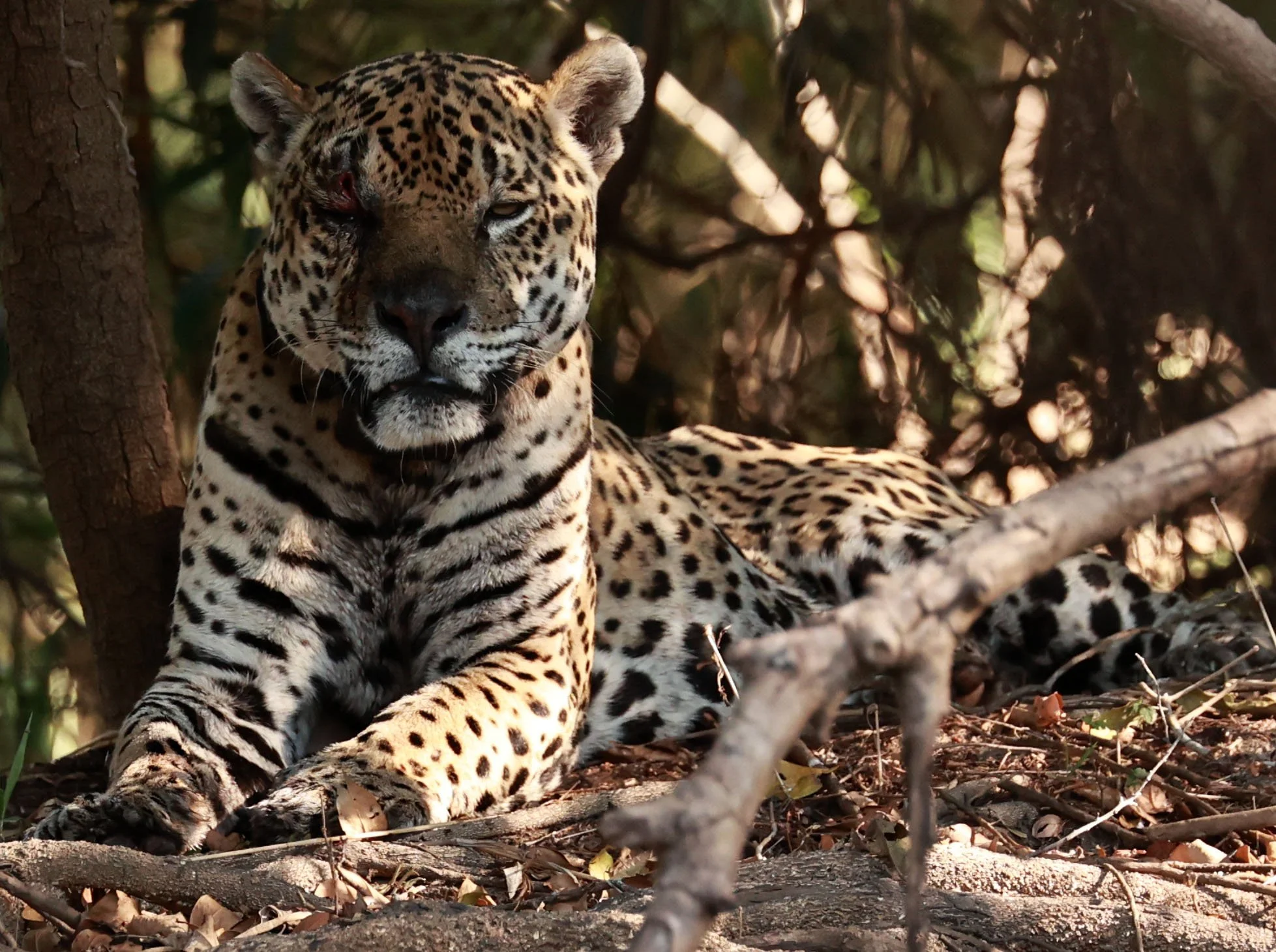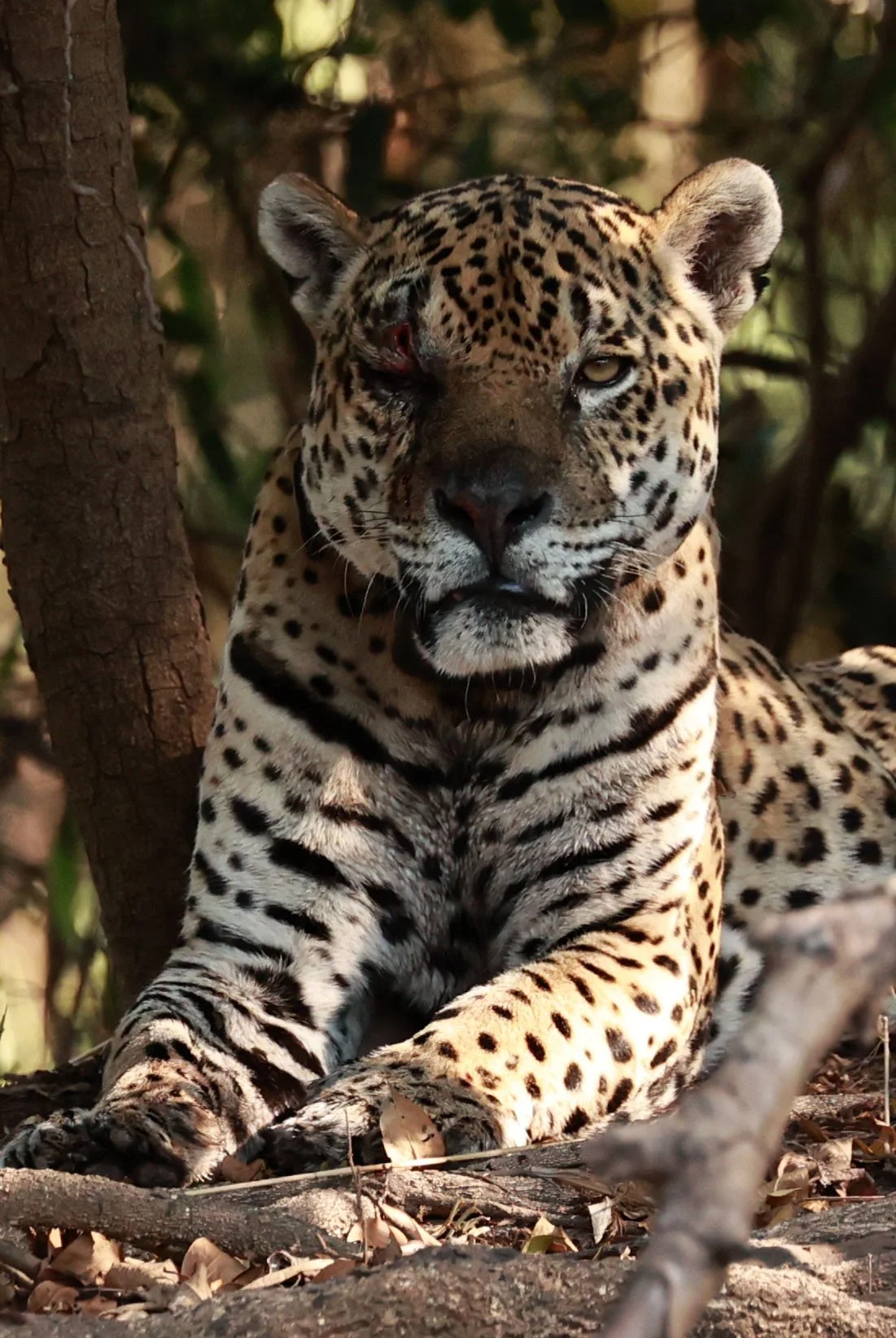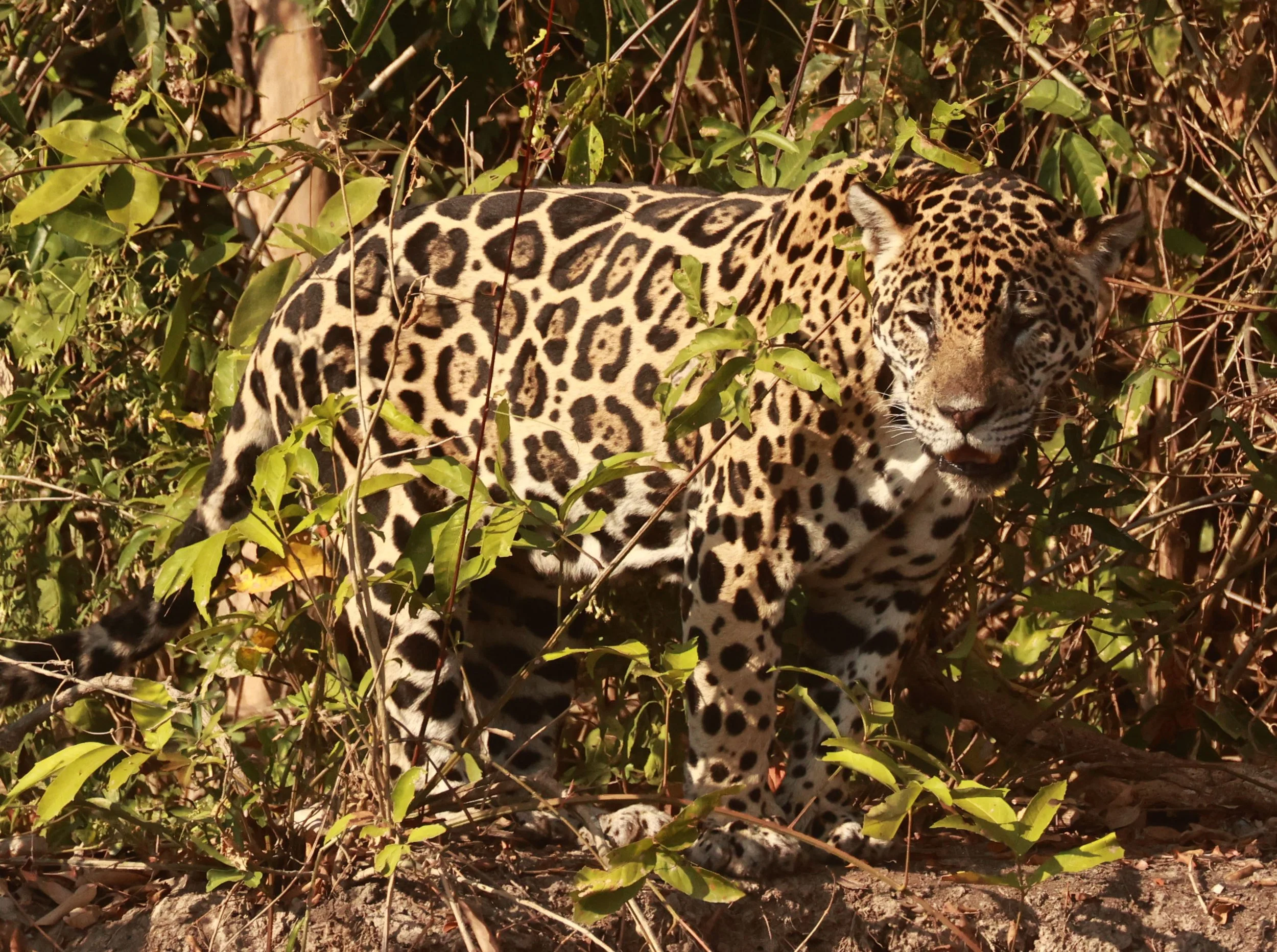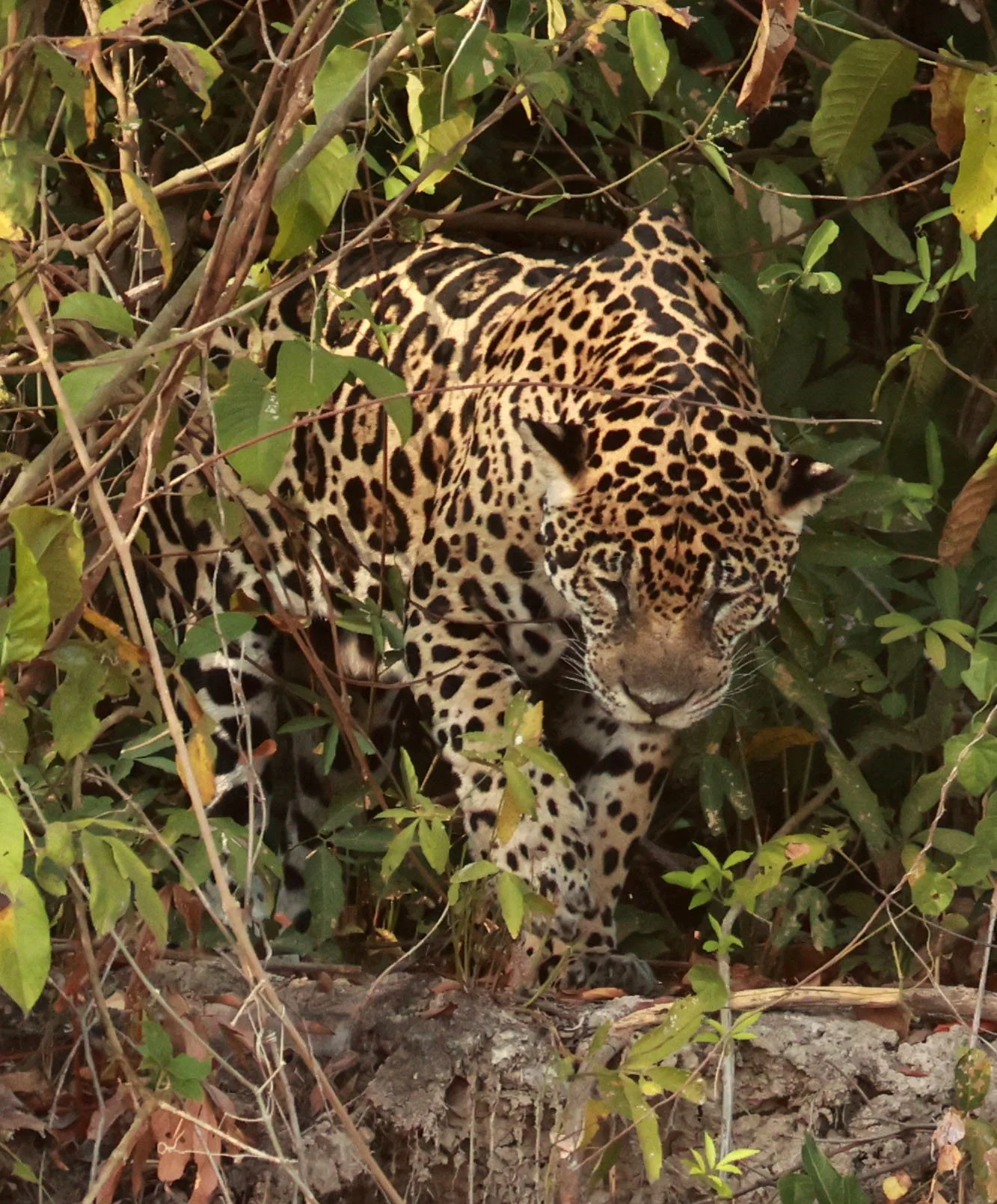
The Jaguar (Panthera onca) is a large cat species and the only living member of the genus Panthera native to the Americas. With a body length of up to 1.85 m (6 ft 1 in) and a weight of up to 158 kg (348 lb), it is the biggest cat species in the Americas and the third largest in the world. Its distinctively marked coat features pale yellow to tan colored fur covered by spots that transition to rosettes on the sides, although a melanistic black coat appears in some individuals. The jaguar's powerful bite allows it to pierce the carapaces of turtles and tortoises, and to employ an unusual killing method: it bites directly through the skull of mammalian prey between the ears to deliver a fatal blow to the brain.
The modern jaguar's ancestors probably entered the Americas from Eurasia during the Early Pleistocene via the land bridge that once spanned the Bering Strait. Today, the jaguar's range extends from the Southwestern United States across Mexico and much of Central America, the Amazon rainforest and south to Paraguay and northern Argentina. It inhabits a variety of forested and open terrains, but its preferred habitat is tropical and subtropical moist broadleaf forest, wetlands and wooded regions. It is adept at swimming and is largely a solitary, opportunistic, stalk-and-ambush apex predator. As a keystone species, it plays an important role in stabilizing ecosystems and in regulating prey populations.
The jaguar is threatened by habitat loss, habitat fragmentation, poaching for trade with its body parts and killings in human–wildlife conflict situations, particularly with ranchers in Central and South America. It has been listed as Near Threatened on the IUCN Red List since 2002. The wild population is thought to have declined since the late 1990s. Priority areas for jaguar conservation comprise 51 Jaguar Conservation Units (JCUs), defined as large areas inhabited by at least 50 breeding jaguars. The JCUs are located in 36 geographic regions ranging from Mexico to Argentina.
The jaguar has featured prominently in the mythology of indigenous peoples of the Americas, including those of the Aztec and Maya civilizations.
In 1758, Carl Linnaeus described the jaguar in his work Systema Naturae and gave it the scientific name Felis onca.
In the 19th and 20th centuries, several jaguar type specimens formed the basis for descriptions of subspecies. In1939, Reginald Innes Pocock recognized eight subspecies based on the geographic origins and skull morphology of these specimens. Pocock did not have access to sufficient zoological specimens to critically evaluate their subspecific status but expressed doubt about the status of several. Later consideration of his work suggested only three subspecies should be recognized. The description of P. o. palustris was based on a fossil skull.
By 2005, nine subspecies were considered to be valid taxa:
Panthera onca onca resting between hunts in Encontro das Águas State Park, Porto Jofre, Cuiaba River, Brazil
P. o. onca (Linnaeus, 1758) was a jaguar from Brazil.
P. o. peruviana (De Blainville, 1843) was a jaguar skull from Peru.
P. o. hernandesii (Gray, 1857) was a jaguar from Mazatlán in Mexico.
P. o. palustris (Ameghino, 1888) was a fossil jaguar mandible excavated in the Sierras Pampeanas of Córdova District, Argentina.
P. o. centralis (Mearns, 1901) was a skull of a male jaguar from Talamanca, Costa Rica.
P. o. goldmani (Mearns, 1901) was a jaguar skin from Yohatlan in Campeche, Mexico.
P. o. paraguensis (Hollister, 1914) was a skull of a male jaguar from Paraguay.
P. o. arizonensis (Goldman, 1932) was a skin and skull of a male jaguar from the vicinity of Cibecue, Arizona.
P. o. veraecrucis (Nelson and Goldman, 1933) was a skull of a male jaguar from San Andrés Tuxtla in Mexico.
Reginald Innes Pocock placed the jaguar in the genus Panthera and observed that it shares several morphological features with the leopard (P. pardus). He, therefore, concluded that they are most closely related to each other. Results of morphological and genetic research indicate a clinal north–south variation between populations, but no evidence for subspecific differentiation. DNA analysis of 84 jaguar samples from South America revealed that the gene flow between jaguar populations in Colombia was high in the past. Since 2017, the jaguar is considered to be a monotypic taxon, though the modern Panthera onca onca is still distinguished from two fossil subspecies, Panthera onca augusta and Panthera onca mesembrina.
The Panthera lineage is estimated to have genetically diverged from the common ancestor of the Felidae around 9.32 to 4.47 million years ago to 11.75 to 0.97 million years ago, and the geographic origin of the genus is most likely northern Central Asia. Some genetic analyses place the jaguar as a sister species to the lion with which it diverged 3.46 to 1.22 million years ago, but other studies place the lion closer to the leopard.
The lineage of the jaguar appears to have originated in Africa and spread to Eurasia 1.95–1.77 mya. The modern species may have descended from Panthera gombaszoegensis, which is thought to have entered the American continent via Beringia, the land bridge that once spanned the Bering Strait. Fossils of modern jaguars have been found in North America dating to over 850,000 years ago. Results of mitochondrial DNA analysis of 37 jaguars indicate that current populations evolved between 510,000 and 280,000 years ago in northern South America and subsequently recolonized North and Central America after the extinction of jaguars there during the Late Pleistocene.
Jaguar in Northern Pantanal
The jaguar is a compact and muscular animal. It is the largest cat native to the Americas and the third largest in the world, exceeded in size only by the tiger and the lion. It stands 68 to 75 cm (26.8 to 29.5 in) tall at the shoulders.[34] Its size and weight vary considerably depending on sex and region: weights in most regions are normally in the range of 56–96 kg (123–212 lb). Exceptionally big males have been recorded to weigh as much as 158 kg (348 lb). The smallest females from Middle America weigh about 36 kg (79 lb). It is sexually dimorphic, with females typically being 10–20% smaller than males. The length from the nose to the base of the tail varies from 1.12 to 1.85 m (3 ft 8 in to 6 ft 1 in). The tail is 45 to 75 cm (18 to 30 in) long and the shortest of any big cat. Its muscular legs are shorter than the legs of other Panthera species with similar body weight.
Size tends to increase from north to south. Jaguars in the Chamela-Cuixmala Biosphere Reserve on the Pacific coast of central Mexico weighed around 50 kg (110 lb). Jaguars in Venezuela and Brazil are much larger, with average weights of about 95 kg (209 lb) in males and of about 56–78 kg (123–172 lb) in females.
The jaguar's coat ranges from pale yellow to tan or reddish-yellow, with a whitish underside and covered in black spots. The spots and their shapes vary: on the sides, they become rosettes which may include one or several dots. The spots on the head and neck are generally solid, as are those on the tail where they may merge to form bands near the end and create a black tip. They are elongated on the middle of the back, often connecting to create a median stripe, and blotchy on the belly. These patterns serve as camouflage in areas with dense vegetation and patchy shadows. Jaguars living in forests are often darker and considerably smaller than those living in open areas, possibly due to the smaller numbers of large, herbivorous prey in forest areas.
The jaguar closely resembles the leopard but is generally more robust, with stockier limbs and a more square head. The rosettes on a jaguar's coat are larger, darker, fewer in number and have thicker lines, with a small spot in the middle. It has powerful jaws with the third-highest bite force of all felids, after the tiger and the lion. It has an average bite force at the canine tip of 887.0 Newton and a bite force quotient at the canine tip of 118.6. A 100 kg (220 lb) jaguar can bite with a force of 4.939 kN (1,110 lbf) with the canine teeth and 6.922 kN (1,556 lbf) at the carnassial notch.
Melanistic jaguars are also known as black panthers. The black morph is less common than the spotted one. Black jaguars have been documented in Central and South America. Melanism in the jaguar is caused by deletions in the melanocortin 1 receptor gene and inherited through a dominant allele.[45] Black jaguars occur at higher densities in tropical rainforest and are more active during the daytime. This suggests that melanism provides camouflage in dense vegetation with high illumination.
In 2004, a camera trap in the Sierra Madre Occidental mountains photographed the first documented black jaguar in Northern Mexico. Black jaguars were also photographed in Costa Rica's Alberto Manuel Brenes Biological Reserve, in the mountains of the Cordillera de Talamanca, in Barbilla National Park and in eastern Panama.
In 1999, the jaguar's historic range at the turn of the 20th century was estimated at 19,000,000 km2 (7,300,000 sq mi), stretching from the southern United States through Central America to southern Argentina. By the turn of the 21st century, its global range had decreased to about 8,750,000 km2 (3,380,000 sq mi), with most declines in the southern United States, northern Mexico, northern Brazil, and southern Argentina. Its present range extends from Mexico through Central America to South America comprising Belize, Guatemala, Honduras, Nicaragua, Costa Rica, particularly on the Osa Peninsula, Panama, Colombia, Venezuela, Guyana, Suriname, French Guiana, Ecuador, Peru, Bolivia, Brazil, Paraguay and Argentina. It is considered to be locally extinct in El Salvador and Uruguay.
Jaguars have been occasionally sighted in Arizona, New Mexico and Texas. Between 2012 and 2015, a male vagrant jaguar was recorded in 23 locations in the Santa Rita Mountains.
The jaguar prefers dense forest and typically inhabits dry deciduous forests, tropical and subtropical moist broadleaf forests, rainforests and cloud forests in Central and South America; open, seasonally flooded wetlands, dry grassland and historically also oak forests in the United States. It has been recorded at elevations up to 3,800 m (12,500 ft) but avoids montane forests. It favors riverine habitat and swamps with dense vegetation cover. In the Mayan forests of Mexico and Guatemala, 11 GPS-collared jaguars preferred undisturbed dense habitat away from roads; females avoided even areas with low levels of human activity, whereas males appeared less disturbed by human population density. A young male jaguar was also recorded in the semi-arid Sierra de San Carlos at a waterhole.
Panther cub in the Pantanal observing mom’s hunting techniques.
In the 19th century, the jaguar was still sighted at the North Platte River 48–80 km (30–50 mi) north of Longs Peak in Colorado, in coastal Louisiana, northern Arizona and New Mexico. Multiple verified zoological reports of the jaguar are known in California, two as far north as Monterey in 1814 and 1826. The only record of an active jaguar den with breeding adults and kittens in the United States was in the Tehachapi Mountains of California prior to 1860. The jaguar persisted in California until about 1860. The last confirmed jaguar in Texas was shot in 1948, 4.8 km (3 mi) southeast of Kingsville, Texas. In Arizona, a female was shot in the White Mountains in 1963. By the late 1960s, the jaguar was thought to have been extirpated in the United States. Arizona outlawed jaguar hunting in 1969, but by then no females remained, and over the next 25 years only two males were sighted and killed in the state. In 1996, a rancher and hunting guide from Douglas, Arizona came across a jaguar in the Peloncillo Mountains and became a researcher on jaguars, placing trail cameras, which recorded four more jaguars.
The jaguar is mostly active at night and during twilight. However, jaguars living in densely forested regions of the Amazon Rainforest and the Pantanal are largely active by day, whereas jaguars in the Atlantic Forest are primarily active by night. The activity pattern of the jaguar coincides with the activity of its main prey species. Jaguars are good swimmers and play and hunt in the water, possibly more than tigers. They have been recorded moving between islands and the shore. Jaguars are also good at climbing trees but do so less often than cougars.
The adult jaguar is an apex predator, meaning it is at the top of the food chain and is not preyed upon in the wild. The jaguar has also been termed a keystone species, as it is assumed that it controls the population levels of prey such as herbivorous and seed-eating mammals and thus maintains the structural integrity of forest systems. However, field work has shown this may be natural variability, and the population increases may not be sustained. Thus, the keystone predator hypothesis is not accepted by all scientists.
The jaguar is sympatric with the cougar (Puma concolor). In central Mexico, both prey on white-tailed deer (Odocoileus virginianus), which makes up 54% and 66% of jaguar and cougar's prey, respectively. In northern Mexico, the jaguar and the cougar share the same habitat, and their diet overlaps dependent on prey availability. Jaguars seemed to prefer deer and calves. In Mexico and Central America, neither of the two cats are considered to be the dominant predator. In South America, the jaguar is larger than the cougar and tends to take larger prey, usually over 22 kg (49 lb). The cougar's prey usually weighs between 2 and 22 kg (4 and 49 lb), which is thought to be the reason for its smaller size. This situation may be advantageous to the cougar. Its broader prey niche, including its ability to take smaller prey, may give it an advantage over the jaguar in human-altered landscapes.
The jaguar has a powerful bite that allows it to pierce the shells of armored prey.
The jaguar is an obligate carnivore and depends solely on flesh for its nutrient requirements. An analysis of 53 studies documenting the diet of the jaguar revealed that its prey ranges in weight from 1 to 130 kg (2.2 to 286.6 lb); it prefers prey weighing 45–85 kg (99–187 lb), with the capybara (Hydrochoerus hydrochaeris) and the giant anteater (Myrmecophaga tridactyla) being the most selected. When available, it also preys on marsh deer (Blastocerus dichotomus), southern tamandua (Tamandua tetradactyla), collared peccary (Dicotyles tajacu) and black agouti (Dasyprocta fuliginosa). In floodplains, jaguars opportunistically take reptiles such as turtles and caimans. Consumption of reptiles appears to be more frequent in jaguars than in other big cats. One remote population in the Brazilian Pantanal is recorded to primarily feed on aquatic reptiles and fish. The jaguar also preys on livestock in cattle ranching areas where wild prey is scarce. The daily food requirement of a captive jaguar weighing 34 kg (75 lb) was estimated at 1.4 kg (3.1 lb) of meat.
The jaguar's bite force allows it to pierce the carapaces of the yellow-spotted Amazon river turtle (Podocnemis unifilis) and the yellow-footed tortoise (Chelonoidis denticulatus). It employs an unusual killing method: it bites mammalian prey directly through the skull between the ears to deliver a fatal bite to the brain. It kills capybara by piercing its canine teeth through the temporal bones of its skull, breaking its zygomatic arch and mandible and penetrating its brain, often through the ears. It has been hypothesized to be an adaptation to cracking open turtle shells; armored reptiles may have formed an abundant prey base for the jaguar following the late Pleistocene extinctions. However, this is disputed, as even in areas where jaguars prey on reptiles, they are still taken relatively infrequently compared to mammals in spite of their greater abundance.
Between October 2001 and April 2004, 10 jaguars were monitored in the southern Pantanal. In the dry season from April to September, they killed prey at intervals ranging from one to seven days; and ranging from one to 16 days in the wet season from October to March.
Jaguars are excellent swimmers. This one was seen swimming near the Cuiaba River in the Northern Pantanal.
The jaguar uses a stalk-and-ambush strategy when hunting rather than chasing prey. The cat will slowly walk down forest paths, listening for and stalking prey before rushing or ambushing. The jaguar attacks from cover and usually from a target's blind spot with a quick pounce; the species' ambushing abilities are considered nearly peerless in the animal kingdom by both indigenous people and field researchers and are probably a product of its role as an apex predator in several different environments. The ambush may include leaping into water after prey, as a jaguar is quite capable of carrying a large kill while swimming; its strength is such that carcasses as large as a heifer can be hauled up a tree to avoid flood levels. After killing prey, the jaguar will drag the carcass to a thicket or other secluded spot. It begins eating at the neck and chest. The heart and lungs are consumed, followed by the shoulders.
The jaguar is threatened by loss and fragmentation of habitat, illegal killing in retaliation for livestock depredation and for illegal trade in jaguar body parts. It is listed as Near Threatened on the IUCN Red List since 2002, as the jaguar population has probably declined by 20–25% since the mid-1990s. Deforestation is a major threat to the jaguar across its range. Habitat loss was most rapid in drier regions such as the Argentine pampas, the arid grasslands of Mexico and the southwestern United States.
In 2002, it was estimated that the range of the jaguar had declined to about 46% of its range in the early 20th century. In 2018, it was estimated that its range had declined by 55% in the last century. The only remaining stronghold is the Amazon rainforest, a region that is rapidly being fragmented by deforestation. Between 2000 and 2012, forest loss in the jaguar range amounted to 83.759 km2 (32.340 sq mi), with fragmentation increasing in particular in corridors between Jaguar Conservation Units (JCUs). By 2014, direct linkages between two JCUs in Bolivia were lost, and two JCUs in northern Argentina became completely isolated due to deforestation.
In Mexico, the jaguar is primarily threatened by poaching. Its habitat is fragmented in northern Mexico, in the Gulf of Mexico and the Yucatán Peninsula, caused by changes in land use, construction of roads and tourism infrastructure. In Panama, 220 of 230 jaguars were killed in retaliation for predation on livestock between 1998 and 2014. In Venezuela, the jaguar was extirpated in about 26% of its range in the country since 1940, mostly in dry savannas and unproductive scrubland in the northeastern region of Anzoátegui. In Ecuador, the jaguar is threatened by reduced prey availability in areas where the expansion of the road network facilitated access of human hunters to forests. In the Alto Paraná Atlantic forests, at least 117 jaguars were killed in Iguaçu National Park and the adjacent Misiones Province between 1995 and 2008. Some Afro-Colombians in the Colombian Chocó Department hunt jaguars for consumption and sale of meat. Between 2008 and 2012, at least 15 jaguars were killed by livestock farmers in central Belize.
The international trade of jaguar skins boomed between the end of the Second World War and the early 1970s. Significant declines occurred in the 1960s, as more than 15,000 jaguars were yearly killed for their skins in the Brazilian Amazon alone; the trade in jaguar skins decreased since 1973 when the Convention on International Trade in Endangered Species was enacted. Interview surveys with 533 people in the northwestern Bolivian Amazon revealed that local people killed jaguars out of fear, in retaliation, and for trade. Between August 2016 and August 2019, jaguar skins and body parts were seen for sale in tourist markets in the Peruvian cities of Lima, Iquitos and Pucallpa. Human-wildlife conflict, opportunistic hunting and hunting for trade in domestic markets are key drivers for killing jaguars in Belize and Guatemala. Seizure reports indicate that at least 857 jaguars were involved in trade between 2012 and 2018, including 482 individuals in Bolivia alone; 31 jaguars were seized in China. Between 2014 and early 2019, 760 jaguar fangs were seized that originated in Bolivia and were destined for China. Undercover investigations revealed that the smuggling of jaguar body parts is run by Chinese residents in Bolivia.
The jaguar is listed on CITES Appendix I, which means that all international commercial trade in jaguars or their body parts is prohibited. Hunting jaguars is prohibited in Argentina, Brazil, Colombia, French Guiana, Honduras, Nicaragua, Panama, Paraguay, Suriname, the United States, and Venezuela. Hunting jaguars is restricted in Guatemala and Peru. In Ecuador, hunting jaguars is prohibited, and it is classified as threatened with extinction. In Guyana, it is protected as an endangered species, and hunting it is illegal.
In 1986, the Cockscomb Basin Wildlife Sanctuary was established in Belize as the world's first protected area for jaguar conservation.































































